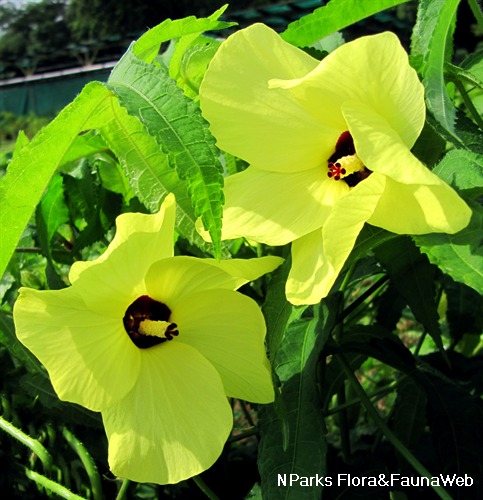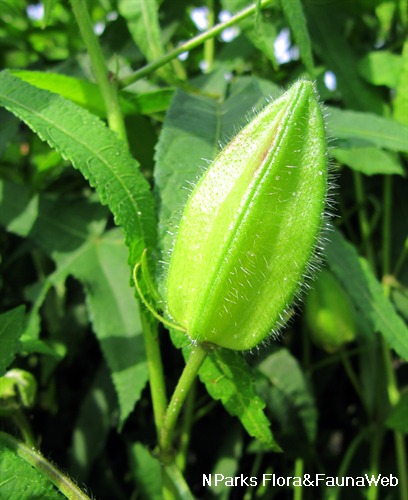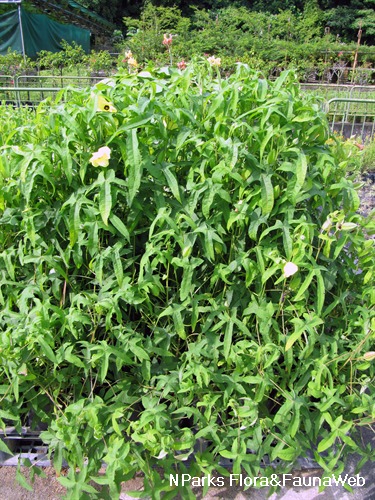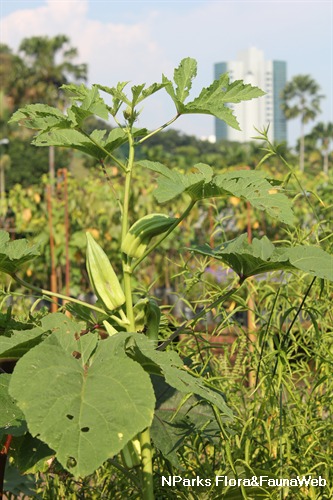
Back
Abelmoschus manihot (L.) Medik.
| Family Name: | Malvaceae |
| Synonyms: | Hibiscus manihot |
| Common Name: | Sunset Hibiscus, Aibika, 黄蜀葵 |
The Sunset Hibiscus (Abelmoschus manihot) is an annual shrub that has big light yellow flowers with maroon to purple central eye and leaves of palmate-shaped leaves. This ornamental species flowers best under full sun.
Name
Classifications and Characteristics
| Plant Division | Angiosperms (Flowering Seed Plants) (Dicotyledon) |
|---|---|
| Plant Growth Form | Shrub |
| Lifespan (in Singapore) | Annual, Perennial |
| Mode of Nutrition | Autotrophic |
| Maximum Height | 1 m to 1.8 m |
| Maximum Plant Spread / Crown Width | 0.9 m |
Biogeography
| Native Distribution | Indian Subcontinent, Laos, Myanmar, Thailand, Vietnam, Malesia, Papuasia, North-Central to South-Central to southeastern China. |
|---|---|
| Native Habitat | Terrestrial |
| Preferred Climate Zone | Tropical, Sub-Tropical / Monsoonal |
| Local Conservation Status | Non-native |
Description and Ethnobotany
| Growth Form | Shrub with woody stem that grows up to 1.8 m tall and 0.9 m wide. |
|---|---|
| Roots | Usually adventitious and fairly shallow. |
| Foliage | The leaves are large, 15-30 cm in diameter, palmate-shaped with 5-9 lobes. The lobes are oblong to lanceolate shaped and sometimes pinnately lobed, measuring 8-18 cm long and 1-6 cm wide. The petiole is 6-18 cm long, stipules linear-lanceolate, sometimes there are 2 on each side of petiole, measuring 1-1.5 cm long. Leaf margin is obtusely serrated. |
| Stems | Erect, woody, branching and pubescent. |
| Flowers | Flowers are solitary or terminal racemes. Each flower is large, bell-shaped, about 12 cm in diameter. The petals are pale yellow with maroon to purple central spot. |
| Fruit | Oblong-ovoid capsule, hairy, usually 5 angled and splitting in 5 segments. The fruit measurement is approximately 4.5 by 2.5 cm. |
| Habitat | Found growing in grasslands, streamsides, and farm margins, at 1000 - 2100 m altitude. |
| Cultivation | Plant grows via seed or stem cuttings. Plant grows slowly during the first 2 - 3 months. When the harvesting started, it requires regular removal of the growing tips to encourage branching and compact bushy growth, and delay flowering. |
| Etymology | The genus Abelmoschus is believed to come from the Arabic terminology which means "source of musk", with reference to the musky smell of fruit capsules. The specific epithet manihot refers to the genus Manihot. |
| Ethnobotanical Uses | Edible Plant Parts : Edible Leaves Food (Fruit or Vegetable): The young leaves and stem tips are cooked as green vegetables in Melanesia region, especially the eastern parts of Indonesian and Papua New Guinea <2>. Medicinal: <a>Scientific Evidence of Medicinal Properties</b> Based on research on the effect of this species on animals, it has these medicinal properties: antidiabetic nephropathy activity <5>, anti-inflammatory <3> and anti-depressant <1>.
<b>Traditional Medicinal Uses</b> In India, the flowers are used in the treatment of chronic bronchitis and toothache <4>.
It is important to note that soem therapeutic effects from traditional medicinal uses of plants are not currently supported or verified by scientific research. |
Landscaping Features
| Landscaping | The shrub can be grown as an annual or perennial in small gardens and parks for its ornamental yellow flowers and foliage. |
|---|---|
| Desirable Plant Features | Ornamental Flowers, Ornamental Foliage |
| Landscape Uses | General, Small Gardens, Container Planting |
| Thematic Landscaping | Economic Garden |
Plant Care and Propagation
| Light Preference | Full Sun |
|---|---|
| Water Preference | Moderate Water |
| Plant Growth Rate | Moderate |
| Rootzone Tolerance | Moist Soils, Well-Drained Soils, Fertile Loamy Soils |
| Potential Problems | The species is closely related to Okra (Abelmoschus esculentus), and thus susceptible to similar pests and diseases. |
| Propagation Method | Seed, Stem Cutting |
| Propagation Ease | Moderate |
| Propagation Method Remarks | The seed has a very hard coat and therefore needs to be knicked for quicker germination. |
| Seed / Spore Germination Duration | 7 days |
Foliar
| Foliage Retention | Evergreen |
|---|---|
| Mature Foliage Colour(s) | Green, Green - Light Green |
| Mature Foliage Texture(s) | Hairy / Hirsute |
| Prominent Young Flush Colour(s) | Green, Green - Light Green |
| Young Flush Texture(s) | Hairy / Hirsute |
| Foliar Type | Simple / Unifoliate |
| Foliar Arrangement Along Stem | Alternate |
| Foliar Attachment to Stem | Petiolate |
| Foliar Shape(s) | Non-Palm Foliage (Palmate) |
| Foliar Venation | Palmate |
| Foliar Margin | Serrate / Toothed, Pinnately Lobed / Pinnatifid, Palmately Lobed |
| Foliar Apex - Tip | Acute |
Floral (Angiosperm)
| Flower & Plant Sexuality | Bisexual Flowers |
| Flower Colour(s) | Yellow / Golden |
|---|---|
| Flower Texture(s) | Thin |
| Flower Grouping | Solitary, Cluster / Inflorescence |
| Flower Location | Axillary, Terminal |
| Flower Symmetry | Radial |
| Individual Flower Shape | Bowl-shaped, Saucer-shaped, Campaulate / Bell-shaped |
| Inflorescence Type | Raceme |
| Flowering Period | Free-Flowering |
| Flower Size | 12 cm x 12 cm |
Fruit, Seed and Spore
| Mature Fruit Colour(s) | Green |
|---|---|
| Mature Fruit Texture(s) | Hairy / Hirsute |
| Fruit Classification | Simple Fruit |
| Fruit Type | |
| Mature Seed Colour(s) | Black |
| Mature Seed Texture(s) | Hairy / Hirsute |
| Seed Description | Seeds are reniform, and has several lines of hairs. |
| Seed Quantity Per Fruit | Numerous (>20) |
References
| References | <1> Guo, J., Xue, C., Duan, J.A., Qian, D., Tang, Y., You, Y. (2011). Anticonvulsant, antidepressant-like activity of Abelmoschus manihot ethanol extract and its potential active components in vivo. Phytomedicine. 18(14):1250-4. <2> Gurnah, A.M. (1993). Abelmoschus manihot (L.) Medikus. In Siemonsma, J.S and Piluek, K (Editors): Plant Resources of South-East Asia No. 8: Vegetables. PROSEA Foundation, Bogor, Indonesia. <3> Jain, P.S., Bari, S.B. (2010). Evaluation of wound healing effect of Abelmoschus manihot in rats. Rev Bras Farmacogn. 20(5):756-61. <4> Todarwal, A., Jain, P., Bari, S. (2011). Abelmoschus manihot Linn: ethnobotany, phytochemistry and pharmacology. Asian Journal of Traditional Medicines. 6(1):1-7. <5> Tu, Y., Sun, W., Wan, Y.G., Che, X.Y., Pu, H.P., Yin, X.J, et al. (2013). Huangkui capsule, an extract from Abelmoschus manihot (L.) medic, ameliorates adriamycin-induced renal inflammation and glomerular injury via inhibiting p38MAPK signaling pathway activity in rats. J. Ethnopharmacol. 147:311-320. |
|---|
Image Repository
Others
| Master ID | 31416 |
|---|---|
| Species ID | 5813 |
| Flora Disclaimer | The information in this website has been compiled from reliable sources, such as reference works on medicinal plants. It is not a substitute for medical advice or treatment and NParks does not purport to provide any medical advice. Readers should always consult his/her physician before using or consuming a plant for medicinal purposes. |







